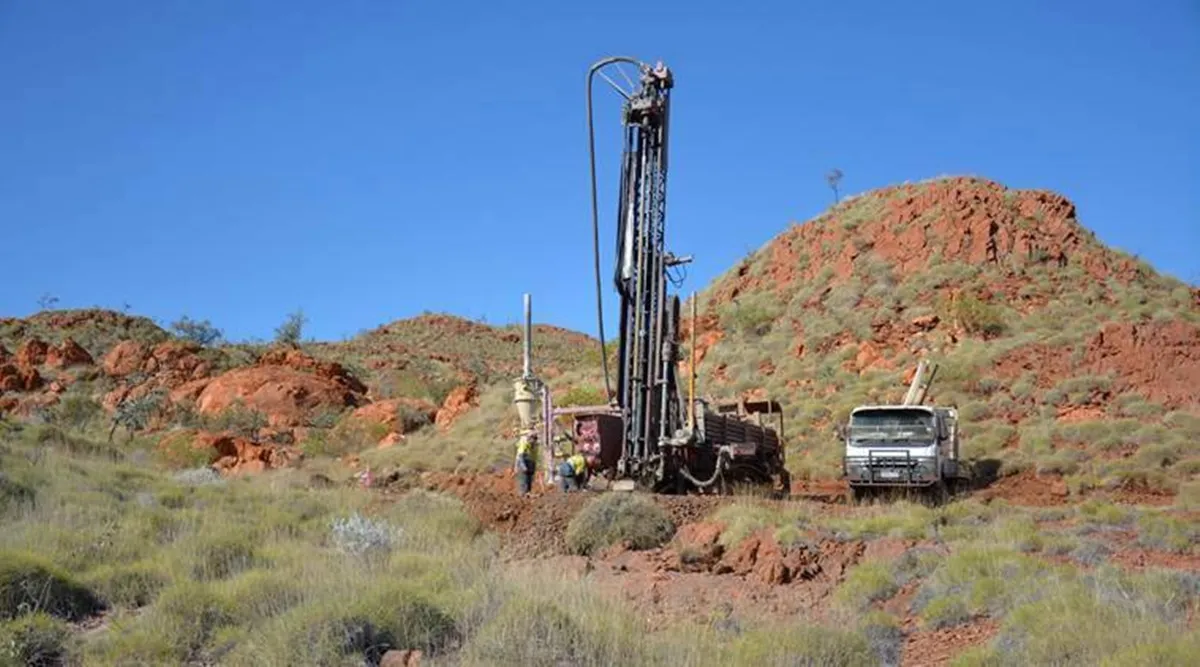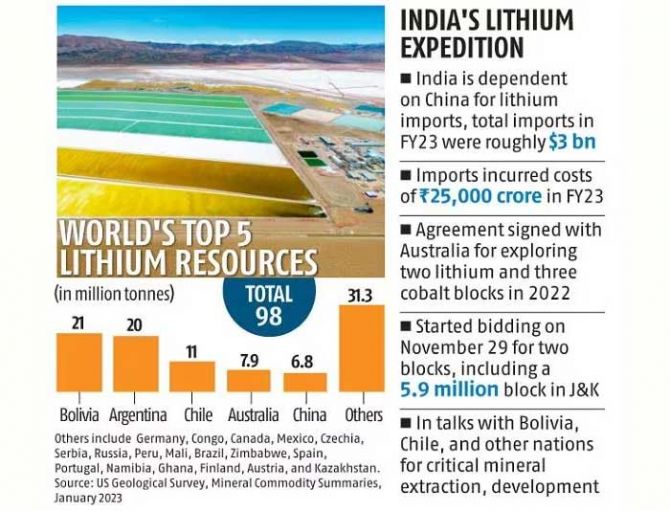
Lithium-Deal: India-Argentina-Australia-Chile
Lithium-Deal: India-Argentina-Australia-Chile
GS-1, 2: Economic Geography, International Relations (UPSC/State PSC)
Why in News:
Recently, the Indian government has decided to enter into Lithium-deal with Argentina, Australia and Chile.
- Lithium is an alkaline mineral, which is also called 'white gold'.
- This mineral is a cornerstone of India's transition to green energy, and its use reduces the carbon footprint.
- Carbon footprint means the total carbon emissions made by any one organization, person or product. These emissions are in the form of carbon dioxide or greenhouse gases.
- India has given priority to exploration of important minerals including lithium in the last one year.
Lithium-deal:
Related point
- The Mines Ministry, through state-owned Mineral Videsh India Limited (KABIL), has signed a draft exploration and development agreement with Argentinian miner Camayen for the possible acquisition and development of five-odd lithium blocks.
- The company has also entered into a non-disclosure agreement with Chilean miner ENAMI for "potential exploration, extraction, processing and commercialization" of the mineral and has appointed a Head of Consulting (PwC) to identify investable projects in Australia.
Mine Acquisition in Argentina
- Acquisition of lithium blocks in Argentina is in "advanced stage". The reported cost of this acquisition is "a few hundred crores".
- According to the Ministry of Mines, KABIL Board has approved the 'Draft Exploration and Development Agreement'.
- Along with this, the proposal to open a branch office in Catamarca, Argentina was approved by the Ministry in June, 2023.
- As of September 2023, there are two active lithium mines in Argentina. Livent operates the Fenix mine in Salta province, while FMC Lithium operates the Hombre Muerto mine in Catamarca province. The Latin-American nation has 14 lithium projects under construction or in the advanced exploration stage.
Lithium reserves: updated figures
- Argentina currently has 21% of the world's lithium reserves, concentrated in the Lithium Triangle, a key partner of India.
- The salt-lake lithium extraction method employed in Argentina proves to be economically favorable, contributing significantly to production.
- Latin American countries, mainly Chile and Argentina, account for 30-35 percent of the world's supply.
- Chile, which has 11 percent of the world's lithium reserves, supplies 26 percent of requirements; While Argentina, with about one-fifth of global resources, supplies about 6 percent.
- Australia is one of the other large lithium producers globally.
 Strategic significance of this agreement:
Strategic significance of this agreement:
- This acquisition is in line with India's pursuit of self-reliance in meeting clean energy demands, especially for electric vehicles.
About Khanij Bidesh India Limited (KABIL):
- Formed in August 2019, state-owned KABIL, which is a joint venture of companies like NALCO, HCL and MECL.
- Its main objective is to identify, acquire, develop, process and commercially exploit strategic minerals in overseas locations.
Global participation
- The venture is currently focusing on sourcing lithium and cobalt – another critical mineral – for the domestic market and is tying up with some companies and projects in Australia, Argentina and Chile.
- KABIL's active engagement with various countries rich in critical minerals, including Bolivia and Chile, underlines India's strategic efforts to diversify its sources and reduce dependence on imports, particularly from Hong Kong and China.
Significance of Lithium Reserves in India:
- Availability of lithium mineral will make the country economically self-reliant.
- It is an important mineral for the manufacture of lithium-ion batteries.
- It has multiple uses in renewable energy technology and electric cars.
Lithium reserves: Global outlook
- Chile, Australia, Argentina, Bolivia, Peru, China and the US are some of the countries in the world that have the largest aggregate lithium reserves.
Lithium Triangle:
- South American countries-Argentina, Bolivia and Chile form the “Lithium Triangle”. According to the U.S. Geological Survey, these three countries, along with Peru, contain about 67% of proven lithium reserves and produce about half of the global supply.
- One-third of the “Lithium Triangle” in South America – which also includes second- and third-place Argentina and Chile – Bolivia is home to the world's largest lithium reserves.
- Argentina has the world's second largest lithium reserves, totaling about 17 million tonnes.
- Salar del Hombre Muerto (Dead Man's Salt Pan) is a salt marsh covering 600 square kilometers on the border between Salta and Catamarca provinces in Argentina. In the Pleistocene period it was a lake, but currently it is a salt water body; Its main tributary is the Río de los Patos.
- The region, part of the Lithium Triangle, is one of the world's most important sources of lithium.
- Chile has approximately nine million tons of lithium reserves. Chile is a country with a prolific mining industry for metals.
- According to the US Geological Survey, the US has the world's fourth largest lithium reserves (6.8 million tonnes).
- Australia ranks fifth in the list of largest overall reserves with 6.3 million tonnes, but it was the world's largest lithium producer in 2019.
- China ranks sixth in the list, with total lithium reserves estimated at 4.5 million tonnes. In 2019, the country produced 7,500 tonnes of the metal – the third highest level worldwide.
Lithium reserves in India
- Lithium reserves recently discovered in the Salal-Haimana area of Reasi district of Jammu and Kashmir (UT) are estimated at 5.9 million tonnes, one of the largest reserves of lithium in the world.
- Earlier, the Atomic Minerals Directorate (under the Atomic Energy Commission of India) had estimated lithium reserves of 14,100 tonnes in Mandya district of southern Karnataka.
- Currently, India meets most of its domestic requirements for manufacturing EVs, lithium-ion batteries and other energy storage solutions entirely through imports. Whose import cost is approximately ₹24,000 Crore.
Conclusion:
This agreement is an important step towards achieving India's goal of becoming a manufacturing hub for electric vehicles by 2070.
Source: The Hindu
--------------------------------------------
Mains Exam Question:
The recent Lithium agreement between India, Argentina, Australia and Chile is an important step for India strategically and commercially. Discuss.